Michelin-starred chefs share their favorite vegetarian dinners that take 20 minutes or less
Anneta Konstantinides

- Insider asked Michelin-starred chefs to share their favorite 20-minute vegetarian dishes.
- You can make a delicious spaghettini with lemon and ricotta in just 11 minutes.
- Or give your falafel a new and quick twist by making them with almonds.
Here at Insider, we've tapped some of our favorite Michelin-starred chefs to give us everything from their favorite 20-minute chicken recipes to their ultimate turkey hacks for holiday meals.
But you don't need meat to make a meal delicious or filling, so we've asked these top chefs for their favorite vegetarian dishes as well.
Better yet? Every recipe takes 20 minute or less.
From a truffle cream toast to the perfect pasta for spring, these vegetarian dishes are sure to make your heart sing.
Spaghettini with lemon and ricotta takes just 11 minutes to put together.
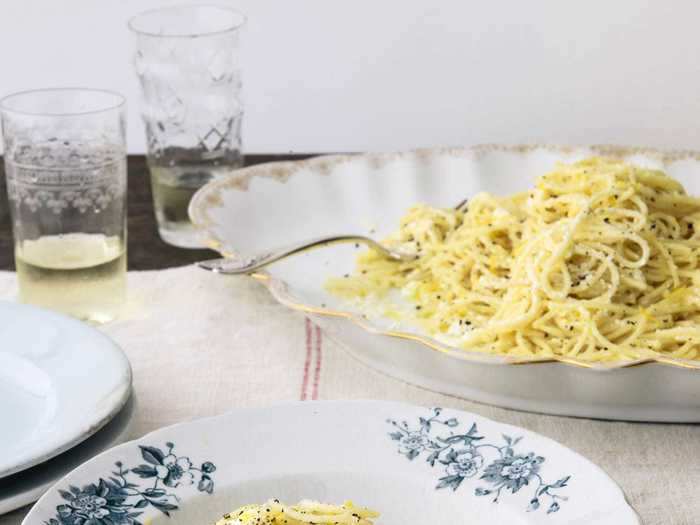
"This lovely, light pasta dish shows off the perfect balance of just a few simple ingredients: mild, creamy ricotta and zesty, bold lemons," Curtis Stone, who runs Maude and Gwen in Los Angeles, told Insider. "You could add sautéed or roasted veggies but, most often, I like to serve this just as is."
To make Stone's spaghettini with lemon and ricotta for four, you'll need: 12 ounces spaghettini, ¾ cup fresh whole-milk ricotta, 2 lemons, 1 ½ tablespoons extra-virgin olive oil, and ½ teaspoon freshly ground black pepper.
First bring a large pot of salted water to a boil over high heat. Then add the spaghettini and cook, stirring occasionally, for about six minutes or until the pasta is tender but still firm to the bite.
"Spaghettini is best when slightly al dente," Stone said. "Its delicate bite and texture are lost if it's overcooked."
Drain your spaghettini and save about half of the pasta water. Meanwhile, in a large bowl, mix the ricotta with your oil and pepper. Grate the zest of one lemon over the ricotta and mix it in. Season with salt.
Add your spaghettini to the ricotta mixture and stir well to coat, adding your reserved pasta water to moisten as needed. Season to taste with salt, then plate your pasta. Finely grate the zest of your second lemon over the pasta, and serve immediately.
Turn toast into an extravagant snack by adding some truffle cream into the mix.
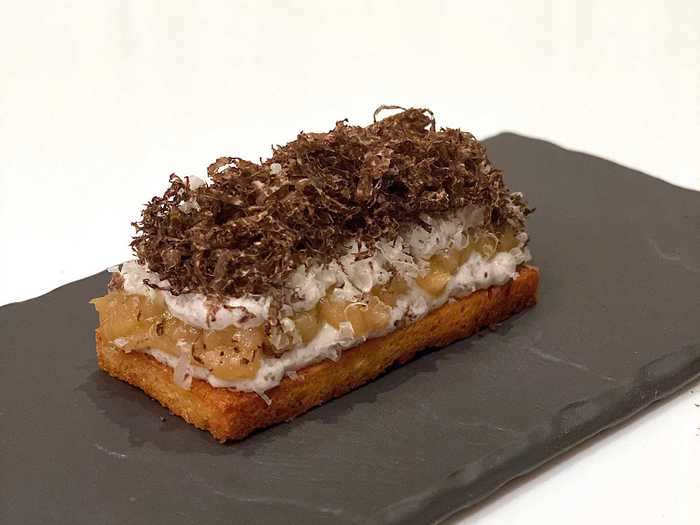
Suyoung Park, the executive chef of Jungsik in New York City, gave Insider this easy but luxurious dish.
To make Park's truffle cream (which she recommends serving on toasted brioche bread), you'll need: 100 grams of sour cream, 13 grams of heavy cream, 2 grams of sea salt, 25 grams of truffle paste, 5 grams of truffle oil, 1 gram of Yondu (a vegetable umami seasoning), and some fresh black truffles (which you can alternatively replace with Grana Padano cheese).
Place all your ingredients for the truffle cream into a bowl, mix well, and then put everything into a piping bag.
Then thinly slice a sweet onion and cook it on low heat with some olive oil until your slices turn golden-brown. Add 1 teaspoon of sherry vinegar, a pinch of potato starch, and blend everything together to make a purée. After it cools, put the purée into a separate piping bag.
Slice your brioche and toast it slowly in a pan on low heat. Plate your brioche and pipe your truffle cream, then pipe your sweet onion purée on top of the truffle cream, covering it.
Park then recommends grinding or shaving black truffles or the cheese on top of the cream to finish, along with a pinch of salt. Then just pair it with a glass of wine or Champagne and enjoy!
You can whip up some kimchi fried rice for lunch or dinner in no time.
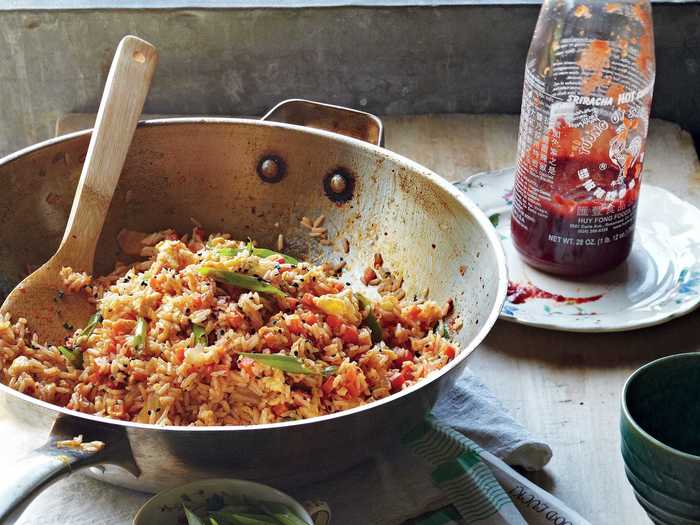
Stone told Insider that he learned how to make the best kimchi fried rice from his Korean mother-in-law Diane.
"Now I know that if you have a jar of kimchi and leftover steamed rice in the fridge, you always have a delicious meal on hand," he said. "We eat this fried rice most often as a main course for dinner, but it can also be served as a side dish."
To make Stone's kimchi fried rice for four, you'll need: 4 cups cold rice, 1 1/2 cups Napa cabbage kimchi (drained and very coarsely chopped), 4 large eggs (beaten), 3 carrots (cut into ¼-inch pieces), 10 scallions, 6 tablespoons canola oil, ¼ cup soy sauce, 2 teaspoons toasted sesame oil, and 1 ½ teaspoons black or white sesame seeds (toasted).
First cut the dark green tops of your scallions on the diagonal into 1-inch pieces, reserving some for your garnish. Then finely chop the white and pale green parts of the scallions.
Heat a wok or large skillet over medium-high heat and add 2 tablespoons of the canola oil, tilting to coat your pan. Add your eggs and quickly stir them for about 30 seconds, until they're just cooked but still wet. Transfer to a plate.
Add your remaining ¼ cup canola oil to the pan. Once the oil is hot, add your rice and cook it, allowing the grains to become slightly crisp on the bottom before stirring, for about four minutes or until it's heated through. Then add your carrots and stir for one minute longer until they begin to soften.
Then add your kimchi, followed by the tops and bottoms of your scallions, and stir for about two minutes or until heated through. Next add the soy sauce and sesame oil and stir for about one minute. Last but not least, stir in your eggs and season with salt to taste.
Transfer your rice to a large serving bowl and sprinkle sesame seeds and your reserved scallions on top. Serve hot with Sriracha.
Stone also recommends making the rice up to one day ahead. Just make sure to cover it and keep refrigerated, then warm it back up in a sauté pan over medium-high heat.
A soba noodle salad is a quick way to brighten up your day.
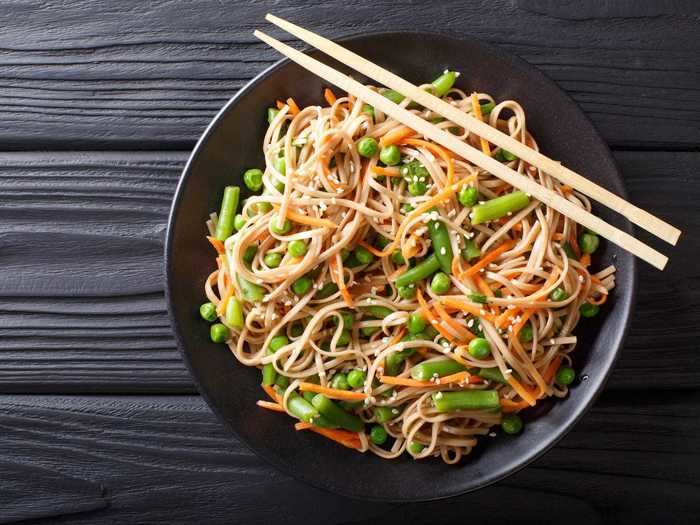
Andrew Zimmerman, the executive chef of Sepia in Chicago, told Insider he's a big fan of whipping up soba noodle salad for lunch.
To start, cook some soba noodles, then rinse and chill them for a few minutes. Then all you have to do is toss them with a rainbow of vegetables.
"For that you've got julienned carrots, thinly-sliced red cabbage, scallions, you can add raw or blanched broccoli to it too, cut up really small if you want," Zimmerman said.
Zimmerman likes to make a quick dressing with gochujang (a Korean pepper paste), some sugar, and a little rice wine vinegar, along with sesame oil and toasted sesame seeds.
"Toss everything together and you've got lots of big flavor," he said. "You can add more vegetables. It's a really flexible format, and it doesn't take really long."
This charred cauliflower steak was inspired by a Southern classic.
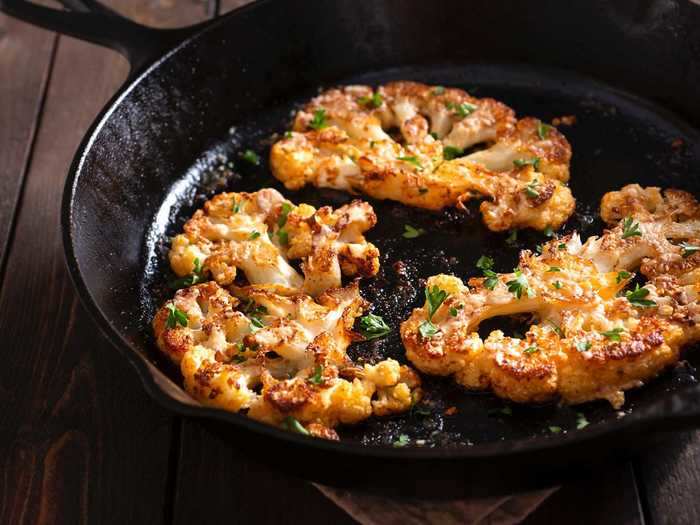
Matt Kirk, who is part of Subtext's "This Week in the Kitchen" cooking campaign, told Insider that this dish was inspired by his grandma's chicken-fried steak.
"I wish I could eat that version every day, but for obvious reasons that's just not possible," he said. "A great alternative that is quick and easy is a charred cauliflower steak with cashew gravy, seasoned breadcrumbs, and a scallion ginger relish."
When it comes to this dish, Kirk said he always starts by whipping up the sauces and garnishes.
To make the cashew gravy, first take a cup of raw unsalted cashews and add them to a small saucepan, covering them with water. Boil the cashews until they're tender, then strain out the liquid and add them to a blender. Add enough fresh water to cover the cashews and blend until they're smooth. Add this mixture back to the saucepan and season with salt and black pepper. Kirk also loves adding green peppercorns in brine into the mix, as well as some Sichuan peppercorns.
Next up is the scallion relish. First take a bunch of scallions and finely chop them. Then add about 1 tablespoon of chopped ginger, 1 teaspoon of sherry vinegar, 1 teaspoon of soy sauce, a couple tablespoons of neutral oil (like grapeseed), and salt to taste. Mix everything together.
Now all you have to do is make your cauliflower steak. Start by smashing store-bought croutons for easy bread crumbs. Then take a head of cauliflower and cut it into 1-inch to 1.5-inch "steaks." Season each one with salt and pepper.
Lightly coat the bottom of a griddle or large skillet with cooking oil and cook one side of the cauliflower for about eight minutes, until it's deeply caramelized.
Smother it with gravy, relish, and breadcrumbs, and you're done!
Penne pasta with mushrooms takes less than 15 minutes, and it's perfect for date night.
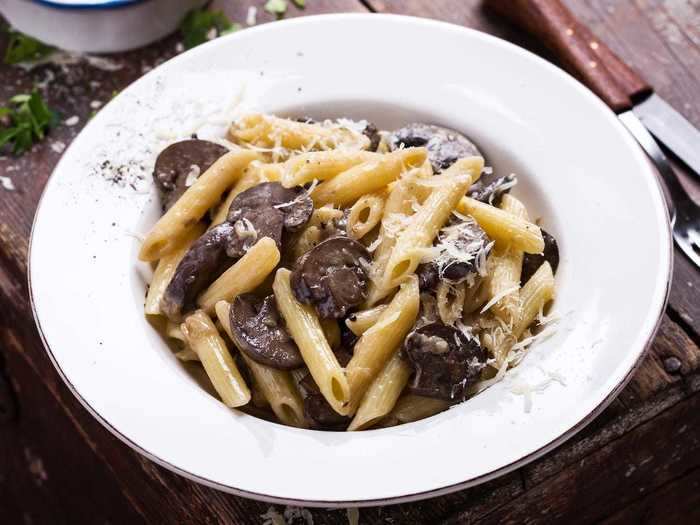
To make Zimmerman's penne con fungi, first bring a pot of salted water to a boil and throw your penne in. Then put some olive oil in a sauté pan that will be big enough to hold your pasta.
After it gets hot, add an assortment of sliced mushrooms and cook them on high heat for five to six minutes.
"Make sure they start to brown," Zimmerman told Insider. "If they brown, they'll have a lot more flavor. Then you're gonna add a little bit of garlic. You want to add the garlic after the mushrooms or else you'll burn it."
Another ingredient that Zimmerman likes to add for flavor are dried porcini mushrooms.
"You can use other dried mushrooms, but dried porcini is my favorite," he said. "Hydrate those with a little bit of hot water so they're soaking. After they soak for about five to seven minutes, add a couple of tablespoons of the porcini soaking liquid into the pan. Then chop them up a bit and throw them into the pan."
Add half a teaspoon of cream and some fresh thyme, and let your cream simmer and reduce a bit until your pasta is almost cooked (it should take about 10-12 minutes to cook the penne).
"Transfer the pasta into the mushroom cream sauce, toss it around, and let the pasta finish cooking there," Zimmerman added.
If you want to elevate the dish even more, Zimmerman recommends throwing in half a teaspoon of black truffle paste or a few drops of truffle oil at the very end.
Give your falafel a new twist by making them with almonds.
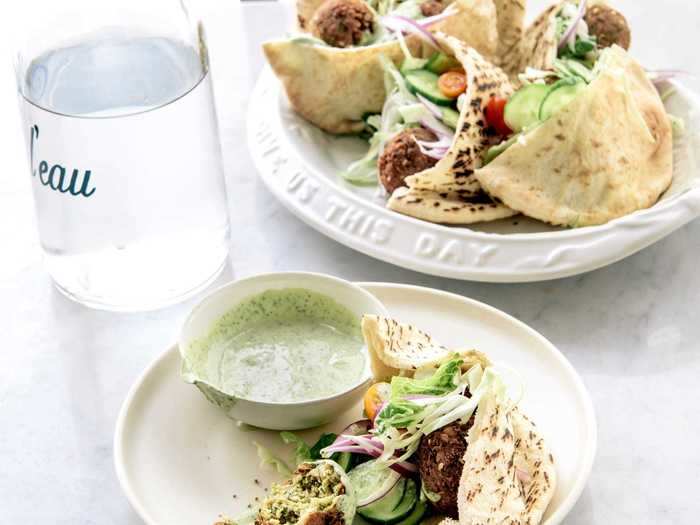
"Traditionally, falafel is made with uncooked chickpeas that have been soaked overnight until they're partially softened, resulting in a crunchy texture," Stone told Insider. "But with that method, falafel can't very well be made on a whim. Using canned chickpeas instead lets you skip the wait, and here the almonds mimic the texture of semi-softened chickpeas — making this satisfying through and through."
To make Stone's almond falafel for six, you'll need: 2 cups of drained, canned chickpeas (rinsed), 1 cup raw whole almonds, ½ onion (coarsely chopped), 4 garlic cloves, ⅔ cup fresh flat-leaf parsley leaves, ½ cup fresh cilantro leaves, ⅓ cup all-purpose flour, 2 tablespoons toasted sesame seeds, 1 tablespoon ground coriander, 1 ½ teaspoons ground cumin, 1 ½ teaspoons kosher salt, 1 ½ teaspoons baking powder, and ½ teaspoon cayenne pepper.
To start, throw your onion, garlic, coriander, cumin, salt, and cayenne pepper into a food processor and pulse until the onion is finely chopped. Then add in the parsley and cilantro and pulse until the herbs are coarsely chopped. Do the same for the almonds, then add the chickpeas and pulse until they're roughly chopped.
Stone said it's important not to over-blend. You want some of the chunky pieces of the almonds and chickpeas to remain intact.
Then transfer your mixture to a bowl and stir in the flour and sesame seeds.
"If you're going to fry the falafel right away, mix in the baking powder," Stone advised. "If you're going to fry the falafel later, cover the mixture and refrigerate for up to 12 hours. Stir in the baking powder just before you shape and fry the falafel."
When you're ready to fry, heat three inches of oil in a large heavy pot at 350 degrees Fahrenheit. Preheat your oven to 200 degrees Fahrenheit and line a large baking sheet with three layers of paper towels.
Then, using about 1 ½ tablespoons of the chickpea mixture for each falafel, form the mixture into balls that are about the size of small walnuts. Working in batches, fry each falafel for three to four minutes or until they're golden brown.
Transfer your fried falafel to the paper towels and season them with salt. Then place the falafel in a baking dish to keep them warm in the oven while you fry the remaining balls.
Then it's just time to plate. Stone recommends serving your almond falafel with warm flatbreads or pita breads, tahini sauce, and veggies including romaine lettuce, green cabbage, red onions, tomatoes, and cucumbers.
This take on risotto uses barley instead of rice, plus plenty of delicious veggies.
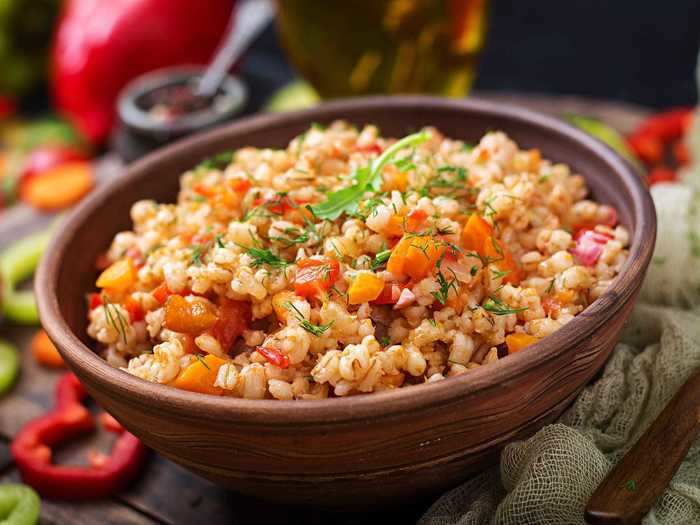
Brad Carter, of Carters of Moseley in Birmingham, England, told Insider he loves making this savory porridge of grains — which is made exactly like a risotto.
First saute some shallots and garlic for your base, then add your barley and vegetable stock "bit by bit" until the grains are cooked through.
"While the grains are cooking, toast some seeds — like pumpkin and sunflower — in a dry pan," Carter said. "Then you can stir the seeds and some puréed green kale — cook it in salted water and put it in a blender — into the grains."
Carter also recommends garnishing your savory porridge with deep fried kale. Just fry some of your kale in hot oil (180 degrees Fahrenheit) until it's crisp, drain and salt it, then pile it right on top.
A nice and light spaghetti dish with garlic, lemon, kale, and parmesan will have you dreaming of spring.
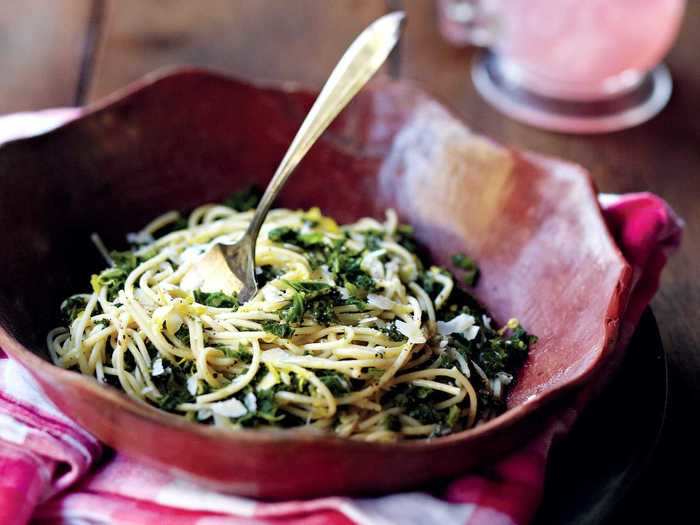
"This pasta doesn't need meat, because the kale has so much character," Stone told Insider. "Any kale will do, but I am partial to the black kale, as it's an Italian variety."
To make Stone's spaghetti dish for four, you'll need: 1 pound spaghetti, 1 pound kale (well-washed, tough stems removed, leaves thinly sliced), 6 garlic cloves, 3 ounces Parmesan cheese (shaved or freshly grated), ¾ cup extra-virgin olive oil, 2 tablespoons lemon zest (grated), and 2 tablespoons fresh lemon juice.
First bring a large pot of salted water to a boil over high heat. Add the kale and cook it for about five minutes, stirring occasionally, until tender. Then, using a mesh spoon or sieve, scoop the kale out of the water and drain it well, transferring it to a bowl.
Return the water to a boil and add the spaghetti, stirring it often to ensure it doesn't stick together. Cook your pasta for about eight minutes, or until tender but still firm to the bite. Drain your spaghetti, saving half a cup of the pasta water.
Heat a large skillet over medium heat and add half a cup of your olive oil as well as the garlic, cooking it for about 30 seconds. Then stir in the kale, add the lemon zest, and season with salt and pepper.
Add the spaghetti and the remaining olive oil to the pan and toss to coat the noodles. Stir in your lemon juice, followed by half of the Parmesan cheese. Season to taste with salt and pepper, then stir in enough of your pasta water to moisten the spaghetti as necessary.
Once you're ready to serve, top the spaghetti with the remainder of the Parmesan cheese.
READ MORE ARTICLES ON
Popular Right Now
Popular Keywords
Advertisement